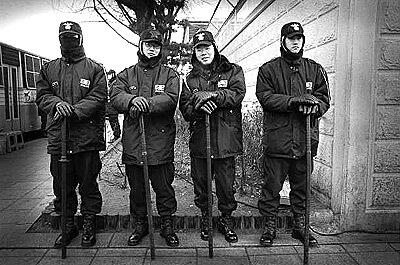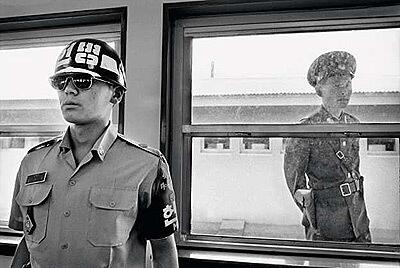
A guard tower maintained by the South Korean army sits along the Freedom Road from Seoul to Panmunjom. (Mark Edward Harris / For the Times)

Soo Yeun Lee, 80, lives in the village of Yangji-ri, in the Civilian Control Zone just outside the southern border of the DMZ. Lee lived here until the Chinese entered the war in 1950, which led to a mass exodus south. She returned in 1973, the year, she says, President Park Chung Hee instituted a government policy to reestablish villages near the border. We dont worry about any attack from the North, she says. There are some inconveniences, but thats life. As she spoke, the women behind her, playing the card game hwatoo, nodded in agreement. Special permission is needed to live in or visit Yangji-ri. (Mark Edward Harris / For the Times)

At the Freedom Bridge over the Imjin River in South Korea hangs a photo of a man separated from his family in North Korea. An estimated 10 million South Koreans have relatives above the DMZ. (Mark Edward Harris / For the Times)
Advertisement

The view looking toward North Korea at the Bridge of No Return in Panmunjom, where prisoners of war from both sides chose whether to return to their homelands at the end of the war in 1953. It was here in 1976 that North Korean soldiers beat U.S. Army Capt. Arthur Bonifas and Lt. Mark Barrett to death as they led a crew attempting to trim a poplar tree that was obstructing the view between two guard posts. In a carefully planned response, American and South Korean forces carried out Operation Paul Bunyan, chopping down the tree. (Mark Edward Harris / For the Times)

I never feel any threat from North Korea, says a young man with his family in Tong-il Chon. Later, my South Korean military escort, Lt. Kyoung Soo Lee, tries to explain such attitudes. Theres been 50 years of peace, so many people dont realize what is happening. We have to be aware of the real situation. My South Korean translator adds: For the young generation, war is just a dictionary word. (Mark Edward Harris / For the Times)

Bathers at the Chulwon Spa Tourist Hotel near the DMZ. (Mark Edward Harris / For the Times)

A temporary amusement park operates on the grounds of the War Memorial of Korea in Seoul. (Mark Edward Harris / For the Times)
Advertisement

Pang Gang Il is church custodian at Tong-il Chon (Unification Village), two miles from the southern boundary of the DMZ. Despite the presence of a Northern military force estimated at 1 million, the Korean War veteran says he is not bothered by the current tensions. The people living in the North are the same as we are, so why worry about it? The war, he says, was a different time. (Mark Edward Harris / For the Times)

Dead animals are put out as food for black vultures, among the endangered migratory birds that have found sanctuary in and along the DMZ. (Mark Edward Harris / For the Times)

The former Communist Labor Party building near the village of Yangji-ri, which was under Communist control from 1945 to 1950. A placard on the building reads: Tortured bodies were buried in a trench behind the building. (Mark Edward Harris / For the Times)

Guards on duty outside the U.S. Embassy in Seoul. When an American policy sparks protest in the South Korean capital, that protest often takes the form of demonstrations held outside the U.S. compound. (Mark Edward Harris / For the Times)
Advertisement

Near the U.S. Embassy in Seoul, students protest an accord between Washington and Seoul that limits S. Koreas ability to prosecute U.S. soldiers. Last year, two girls were killed by a U.S. armored vehicle in Yangju. We learned in school that the U.S. was a close friend, but after the two girls were killed and the soldiers could not be prosecuted, we realized maybe America is not our friend, says Mi Hyun Han, at right. Is she concerned N. Korea will develop nuclear weapons? Kim Jong Il is not that foolish. I dont think they can handle World War III. The U.S. is not that weak. North Korea wants a bargaining chip. (Mark Edward Harris / For the Times)

At Dorasan Station near the DMZ, a sign of hope. The placard directs passengers to a platform where one day they might be able to board a train for the North Korean capital. (Mark Edward Harris / For the Times)




